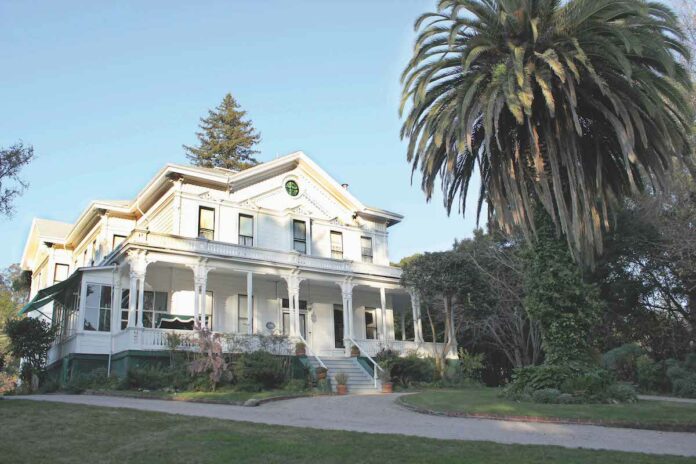Mangels House is an elegant, Victorian, summer mansion in the Aptos hills, built by Claus Mangels, brother-in-law of Claus Spreckels, the sugar millionaire. It is the last remaining example of three nearly identical mansions built between 1872-88.
Claus Mangels was born Sept. 12, 1832, in Baderkase in the independent kingdom of Hanover, before Germany became a country. Peter and Claus Spreckels grew up on a farm in Lamstedt, Germany. They all came to the U.S. as teenagers in 1846 and worked in the grocery business in Charleston, South Carolina.

Claus Spreckels soon owned the business. He married Mangels’ sister Anna, in New York City in 1852. They moved around the country and eventually worked their way to Hangtown (Placerville), in the California gold country where Claus Mangels and Peter Spreckels met twin sisters from Westphalan, (Germany), Agnes and Anna Grosse. The sisters ran a small store and eatery. They sold sandwiches made from old meat or discarded butchers scraps. There was no refrigeration, so they scrubbed the meat in the creek to get the mold off and make it nice and pink. They called it “used meat.”
They arrived in San Francisco by 1856. Claus Mangels and Peter Spreckels married Agnes and Anna Grosse. Claus married Agnes on Jan. 5, 1862. He was 29 and she was 17. In 1863, the three couples started the Bay Sugar Refining Company in San Francisco and prospered. They built grand houses on South Van Ness Avenue. They also founded the Lyons Brewery and the Albany Brewery, and the grocery firms of Spreckels & Co. and H. Bruning & Co.
Mangels’ other sister, Sophia, married Claus Brommer in Hanover. Brommer came to San Francisco in 1869 to work for Spreckels at the sugar company. In 1874, the Brommers bought a 130-acre farm near Schwan Lagoon. Brommer Street is named after him.
Claus Spreckels purchased one-third of Rafael Castro’s Aptos Rancho in 1872 and built a modest, two-story home above the Aptos Creek estuary on today’s Bayview Court off Aptos Beach Drive. By 1874, he had built a modest lodge for guests near Claus Court. This would become part of Spreckels grand Aptos Hotel the following year.
In 1877, Spreckels built a grand summer home where Huntington Drive, Monroe Avenue and Soquel Drive intersect. The address today is 9565 Soquel Drive. The two magnolia trees in the parking lot were at the entrance to Spreckels’ house. A second home was prefabricated and shipped to Honolulu Hawaii for Spreckels to oversee his sugar business in the Sandwich Islands.
The railroad had come to Aptos in 1875 with the assistance of Fredrick Hihn and Claus Spreckels, and by 1882, a rail line was running up Aptos Creek Canyon to service the Loma Prieta lumber mill in which Mangels and Spreckels had an interest. By 1888 they had built a sugar refinery in Watsonville. Claus Mangels was Spreckels’ silent partner. One of his tasks was to talk the local farmers into growing sugar beets. He was also mechanically inclined and invented the Mangels Plow which still bears his name. Agnes Mangels died in 1875. In 1876, Claus married Emma Zweig.
Claus Mangels acquired about 550 acres for his summer ranch house in 1884 and 1887 from Claus Spreckels and Vicente Castro. This third mansion, the “big house,” was built for Claus and Emma Mangels, half a mile up Aptos Creek from the village in 1888, of clear heart redwood from the Loma Prieta Mill. It was a reverse floor plan of the Spreckels mansion. Its 15 rooms include 10 bedrooms, a kitchen and butler’s pantry, two parlors, a dining room, a card room, a full basement, 3,000 square feet of living space on each of its two floors, 14-foot ceilings on the main floor and a full attic topped by a “widows walk.” The architectural style is called “Carpenter’s Gothic.” The house was built for six weeks use in the summer and could sleep 23 people. There was also a tennis court and stables. Spreckels used his San Francisco architect Henry Geilfuss (gile-foos) to design the mansions and longtime Aptos resident Ralph Mattison speculated that Spreckels may have lent his architect to Joseph Arano to design the Bay View Hotel. The summer house was constructed by F. Klatt at a cost of $9,450.
It used to take two days by horse and carriage to come from San Francisco to Aptos. The families stayed overnight at the hotel in Los Gatos before tackling the mountains to Santa Cruz. The ranch became well known as a social center.
Claus Mangels died in San Francisco on April 22, 1891. Claus and his first wife Agnes had five children. Philip died an infant. John Henry and Agnes never married. Anna Lisette Mangels married Ernest Hueter who founded the Dutch Boy Paint Company and the Pioneer Varnish Company which supplied varnish for railroad cars. Emma Marie Mangels married Frederick Tillman, Jr. who originated the Del Monte Brand of canned fruits and vegetables. Frederick and Emma’s daughter Agnes married Baron Jan Carel van Panteleon van Eck who was responsible for bringing the Shell Oil Company to America.
A dairy was established on the ranch in the 1920s. Milk was trucked to Golden State Dairies in Watsonville where they received eight cents per gallon. They would bring back silage for the cows from the lettuce packing plants. Karl Mertz, Mangels’ great-grandson, fondly remembers eating the baby heads of lettuce that were too small for market. The dairy failed during World War II. All of the Swiss and Bavarian milkers went to work for Salz Tannery. The tannery was expanding because of the war and the pay was better.
The estate stayed in the family through four generations. The mansion was sold to Dr. Ron and Jackie Fisher in 1979. Three of Mangels’ great-grandchildren built houses on part of the original estate. Elizabeth (Hueter) Wright, Agnes (van Eck) Reed and Karl Mertz. (Karl donated the old “Arrival of Trains” blackboard from Aptos Station and other historical objects to the Aptos History Museum.)
Minor alterations to the house have occurred over the years. The living room was originally two parlors connected by sliding doors. A card room on the first floor was converted to a bedroom. An oil furnace and a septic system were added, and electricity has replaced the acetylene generator which supplied gas for the lights. The second floor has remained essentially unchanged except for modernizing the plumbing and electricity. Most of the upstairs bedrooms have the original marble wash basins. Karl Mertz “rescued” the last of the original toilets which has “The John Douglas Co.” in large black letters around the rim. These toilets were very popular, and this is where the expression “going to the john” came from. Karl donated the toilet to the Capitola History Museum for display in their “beach cottage.”
The Fishers renovated the house and opened it as an elegant bed and breakfast inn with five guest rooms. Jackie was a charming hostess and enjoyed meeting her guests and preparing wonderful breakfasts that always exceeded expectations. Sadly, Jackie passed away in 2004 and the Mangels House returned to a private residence. Doctor Ron Fisher passed away on Jan. 19, 2017.











